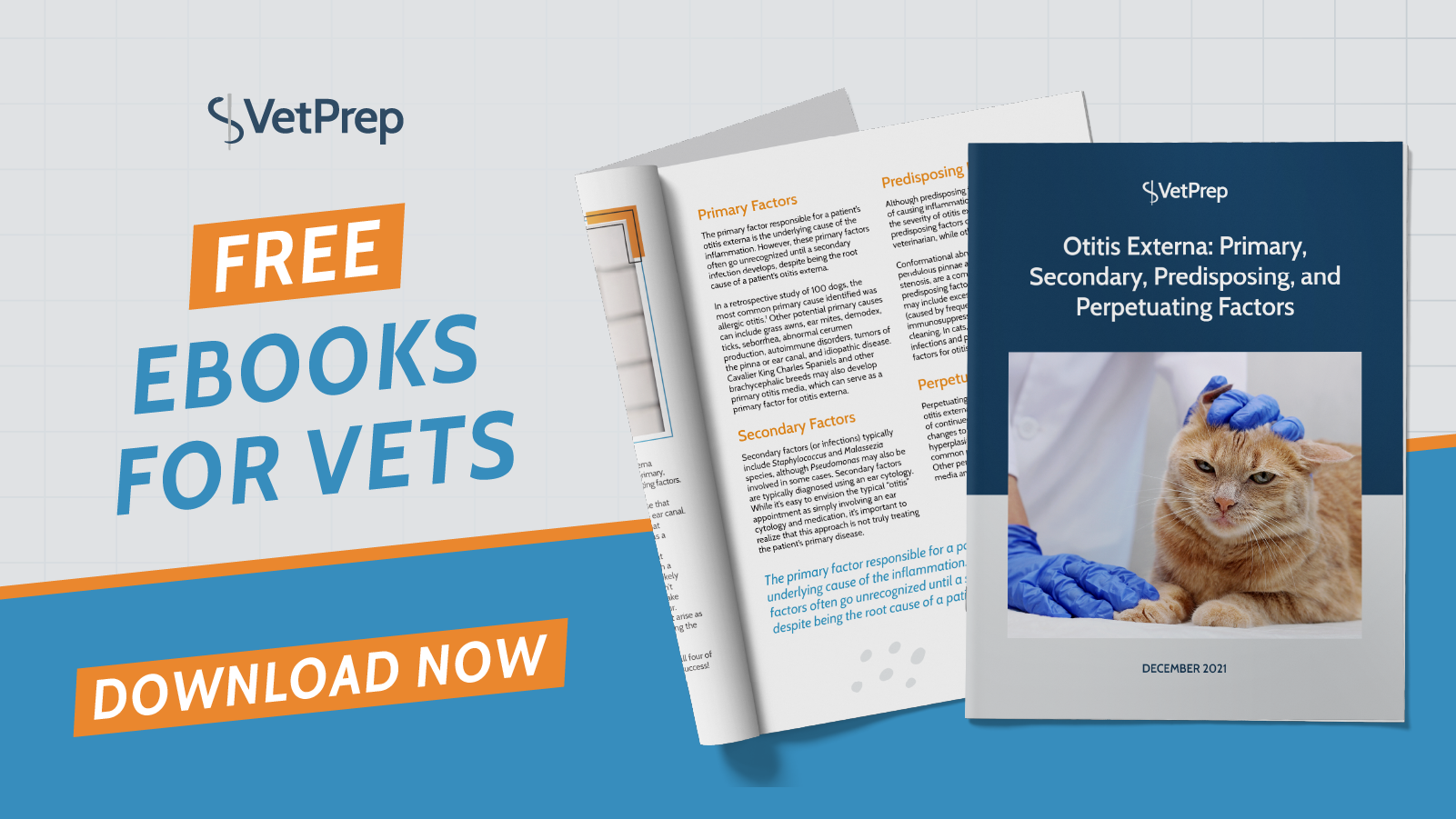
 When you diagnose a patient with otitis externa, you will likely be reaching for topical medication for treatment.
When you diagnose a patient with otitis externa, you will likely be reaching for topical medication for treatment.
Owners often ask if there’s “a pill” they can give instead of having to clean and medicate their dog’s ears, but the reality is that oral medications are typically only used in cases of ulcerative or proliferative otitis externa or when concurrent otitis media is suspected.
When selecting an appropriate topical medication, you need to consider which organisms you are targeting. Many topical ear medications contain a combination of an antibiotic, an antifungal agent, and a corticosteroid.
There aren’t big differences in efficacy between the various antifungals and corticosteroids, so the most important factor in medication selection is often which bacteria (if any) you see on ear cytology. Many practices stock a limited number of topical otic medications, so you will soon learn which of your practice’s medications you will want to reach for in a case of cocci, rods, yeast, or any combination of those organisms.
Active Ingredients in Otic Medications
The agents included in topical otitis medications can be divided into the following categories:
Corticosteroids: Corticosteroids reduce pain, inflammation, and edema in otitis externa. In cases of allergic otitis, topical corticosteroids are often used as the sole therapy for otitis. When infection is present, corticosteroids are often combined with antibiotics and antifungal agents to provide rapid relief of uncomfortable symptoms.
Antibiotics: The appropriate antibiotic choice for otitis depends on cytology results. Aminoglycosides, such as neomycin and gentamicin, are effective against a wide variety of gram-positive and gram-negative infections, so they are often used as first-line antibiotic selections. Fluoroquinolones also have a broad spectrum of activity, but they are typically used as a second-line treatment when aminoglycosides have failed or when Pseudomonas is suspected. Polymyxin also has good activity against Pseudomonas, as does tobramycin ophthalmic solution. Florfenicol is a newer addition to topical otic medications and is used against Staphylococcus pseudintermedius in long-acting topical antibiotic formulations.
Tris-EDTA: Tris-EDTA is often combined with antibiotics when treating gram-negative bacterial infections. Tris-EDTA increases the cell membrane permeability of gram-negative bacteria, improving medication uptake, and also weakens the cell membrane.
Antifungal Medications: Common topical antifungal agents include miconazole, ketoconazole, posaconazole, clotrimazole, terbinafine, nystatin, and thiabendazole. All of these drugs are typically effective against yeast otitis.
Common Otic Medications
|
Medication |
Antibiotic |
Antifungal |
Corticosteroid |
Notes |
|
Baytril® Otic |
Enrofloxacin |
Silver sulfadiazine |
X |
2nd-line therapy, used for Pseudomonas or chronic infections. Administer q12hrs. |
|
Claro® |
Florfenicol |
Terbinafine |
Mometasone |
Primarily used to treat Staphylococcus pseudintermedius. Administer once; effects last up to 30 days. |
|
EasOtic® |
Gentamicin |
Miconazole |
Hydrocortisone |
Broad-spectrum antibiotic coverage. Administer q24hrs for 5 days. |
|
Mometamax® |
Gentamicin |
Clotrimazole |
Mometasone |
Broad-spectrum antibiotic coverage. Administer q24hrs. |
|
Osurnia® |
Florfenicol |
Terbinafine |
Betamethasone |
Primarily used to treat Staphylococcus pseudintermedius. Administer two doses, seven days apart. |
|
Otomax® |
Gentamicin |
Clotrimazole |
Betamethasone |
Broad-spectrum antibiotic coverage. Administer q12hrs. |
|
Posatex® |
Orbifloxacin |
Posaconazole |
Mometasone |
2nd-line therapy, used for Pseudomonas or chronic infections. Administer q24hrs. |
|
Surolan® |
Polymyxin B |
Miconazole |
Prednisolone |
Broad-spectrum antibiotic coverage. Good activity against Pseudomonas, as long as the ear canal is clean. Administer q12hrs. |
|
Synotic® |
X |
X |
Fluocinolone acetonide |
Contains DMSO to help with corticosteroid absorption. Used to treat allergic otitis. Administer q12hrs. |
|
Tresaderm® |
Neomycin |
Thiabendazole |
Dexamethasone |
Broad-spectrum antibiotic coverage. Administer q12hrs. |
|
TrizUltra+Keto® |
Tris-EDTA |
Ketoconazole |
X |
Often used as a pre-treatment cleaner to improve the efficacy of medications directed against Pseudomonas. Can also be an effective sole therapy in mild cases of yeast otitis. |
Don’t Be Overwhelmed!
While the quantity of ear medications on the market can seem overwhelming, there are many similarities between these products, and it’s likely that your first veterinary job will only stock a limited number of medications. For example, Otomax and Mometamax are very similar (differing only in dosing frequency and the corticosteroid they contain), so most practices will only stock one of these medications. Claro and Osurnia are also very similar, so your practice may not stock both options.
When you enter your first job, take a few minutes to make a list of each otitis medication that your practice stocks, then determine which is most appropriate for yeast, cocci, rods, chronic/recurrent infections, and difficult-to-medicate pets.
You don’t need to know everything about every single medication; you just need to understand which of your available medications is the best choice for any given patient.





